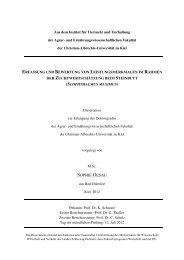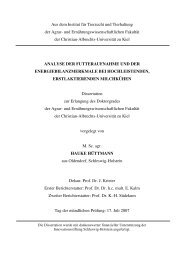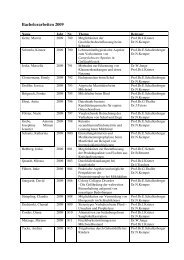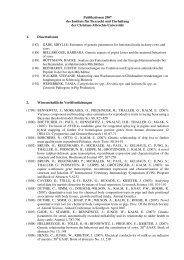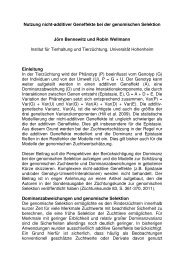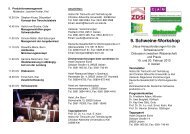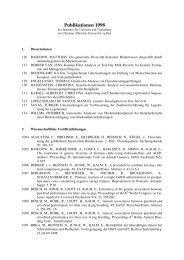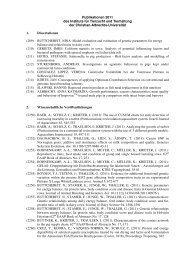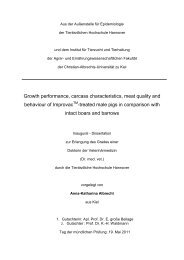Verena Gonzalez Lopez, 2011 - Institut für Tierzucht und Tierhaltung ...
Verena Gonzalez Lopez, 2011 - Institut für Tierzucht und Tierhaltung ...
Verena Gonzalez Lopez, 2011 - Institut für Tierzucht und Tierhaltung ...
Erfolgreiche ePaper selbst erstellen
Machen Sie aus Ihren PDF Publikationen ein blätterbares Flipbook mit unserer einzigartigen Google optimierten e-Paper Software.
In the present study, optimum contribution theory was applied in a small pig<br />
herdbook population. In order to ensure that the different scenarios investigated are<br />
close to practical breeding schemes, specific conditions determined from the local<br />
breeding organization were considered. First, a predefined number of 50 elite sows<br />
should be selected. Moreover, a preselection of candidates has been carried out<br />
based on minimum performance requirements. This was necessary to ensure that<br />
progeny of elite matings can also be sold to potential customers such as artificial<br />
insemination organizations in Germany. Indeed, a considerable number of animals<br />
with high EBV and low relationship value were discarded during the first selection<br />
step. The main criterion causing the loss of potential candidates was the restriction<br />
on carcass length.<br />
Applying the optimum contribution selection, the number of animals selected<br />
increased and the average expected breeding value of selected animals decreased<br />
the more the relationship was constrained. These results were consistent with those<br />
of Weigel and Lin (2002) and König and Simianer (2006). The relation between EBV<br />
and optimized contributions with different constraints on relationship observed in this<br />
study was in accordance with other studies as well (Gr<strong>und</strong>y et al., 1998; Avendaño et<br />
al., 2003). In addition, it was demonstrated that a higher average breeding value of<br />
selected animals could be achieved at a severe relationship constraint by considering<br />
boars from BW. This can be explained by the fact that BW boars had a lower<br />
average R-value to potential candidates compared with SH boars. For this reason,<br />
the largest proportion of selected boars composed of BW boars (Figure 4 and 5).<br />
Individual BW boars were also highly related to the potential SH candidates as a<br />
result of exchange of genetic material between herdbook populations in past<br />
decades (<strong>Gonzalez</strong> <strong>Lopez</strong> et al., unpublished data). Therefore, a targeted application<br />
of BW boars is recommended.<br />
After the selection of elite sows and boars by applying the optimum contribution<br />
selection, minimum coancestry mating with linear programming technique was<br />
applied to define the specific mating between sows and boars. This two-step<br />
selection and mating strategy requires less computer time, compared to a one-step<br />
selection and mating scheme, for example the linear programming algorithm of Toro<br />
and Pérez-Enciso (1990) which have to include all selection candidates. The same<br />
approach has also been applied by Berg et al. (2006), Sonesson and<br />
53



